Investment Appraisal and Corporate Governance in Financial Management
VerifiedAdded on 2023/06/11
|18
|4522
|431
Report
AI Summary
This report provides a comprehensive analysis of financial management decision-making, covering key areas such as capital structure, investment appraisal, and corporate governance. It explores the Modigliani-Miller theory in relation to optimal capital structure, discussing the impact of debt and equity financing on a company's value and weighted average cost of capital. The report also delves into the principles of corporate governance, including accountability, transparency, fairness, and responsibility, and evaluates the need for a stakeholder approach in corporate strategy. Furthermore, it includes calculations of Net Present Value (NPV) and Internal Rate of Return (IRR) for investment projects, along with a discussion of the strengths and weaknesses of the IRR method and ways to incorporate risk into the investment appraisal process. Finally, the report examines methods for assisting managers in making maximizing and minimizing decisions while dealing with capacity limitations, including the calculation of optimal product mix and sales mix to maximize profitability. Desklib offers a wide range of solved assignments and past papers for students.
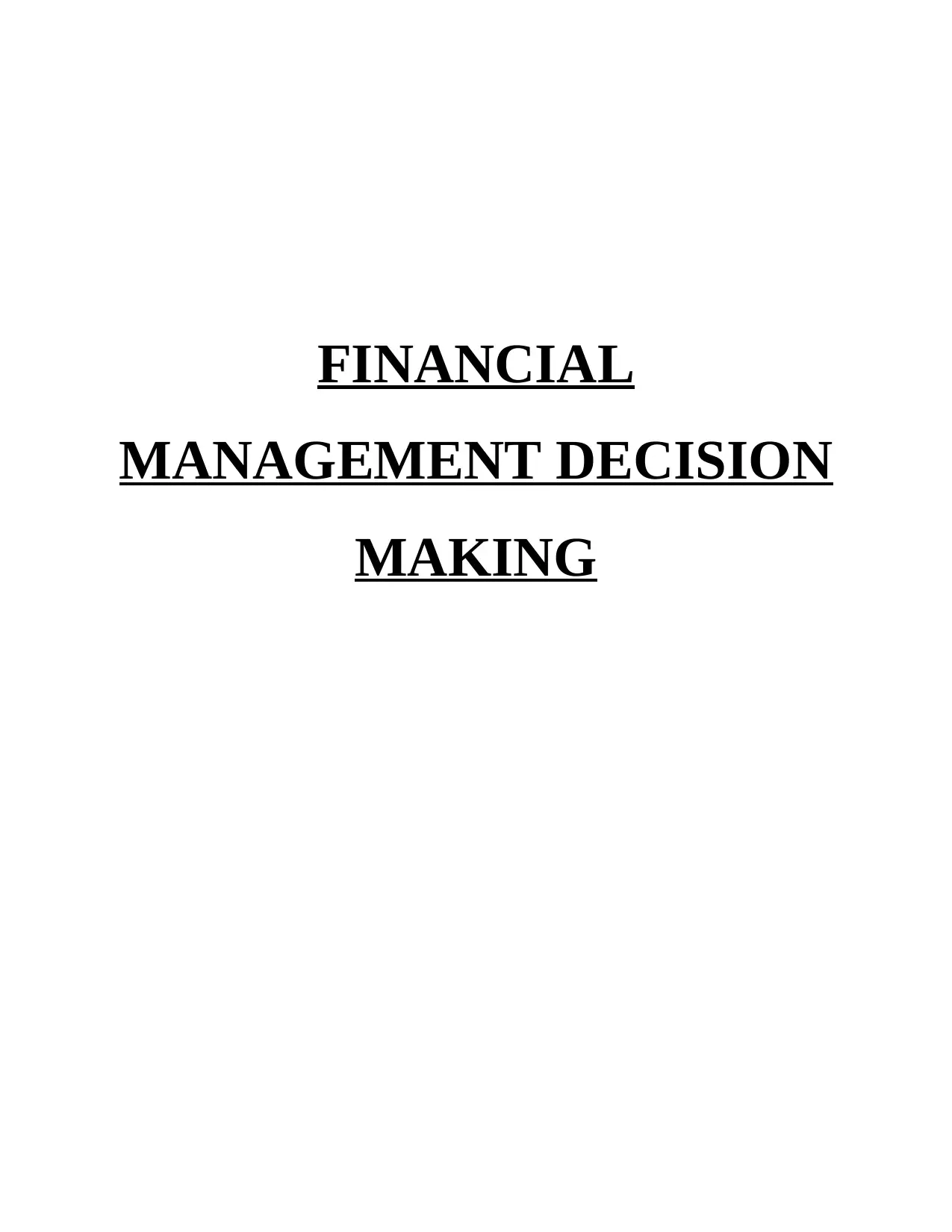
FINANCIAL
MANAGEMENT DECISION
MAKING
MANAGEMENT DECISION
MAKING
Paraphrase This Document
Need a fresh take? Get an instant paraphrase of this document with our AI Paraphraser
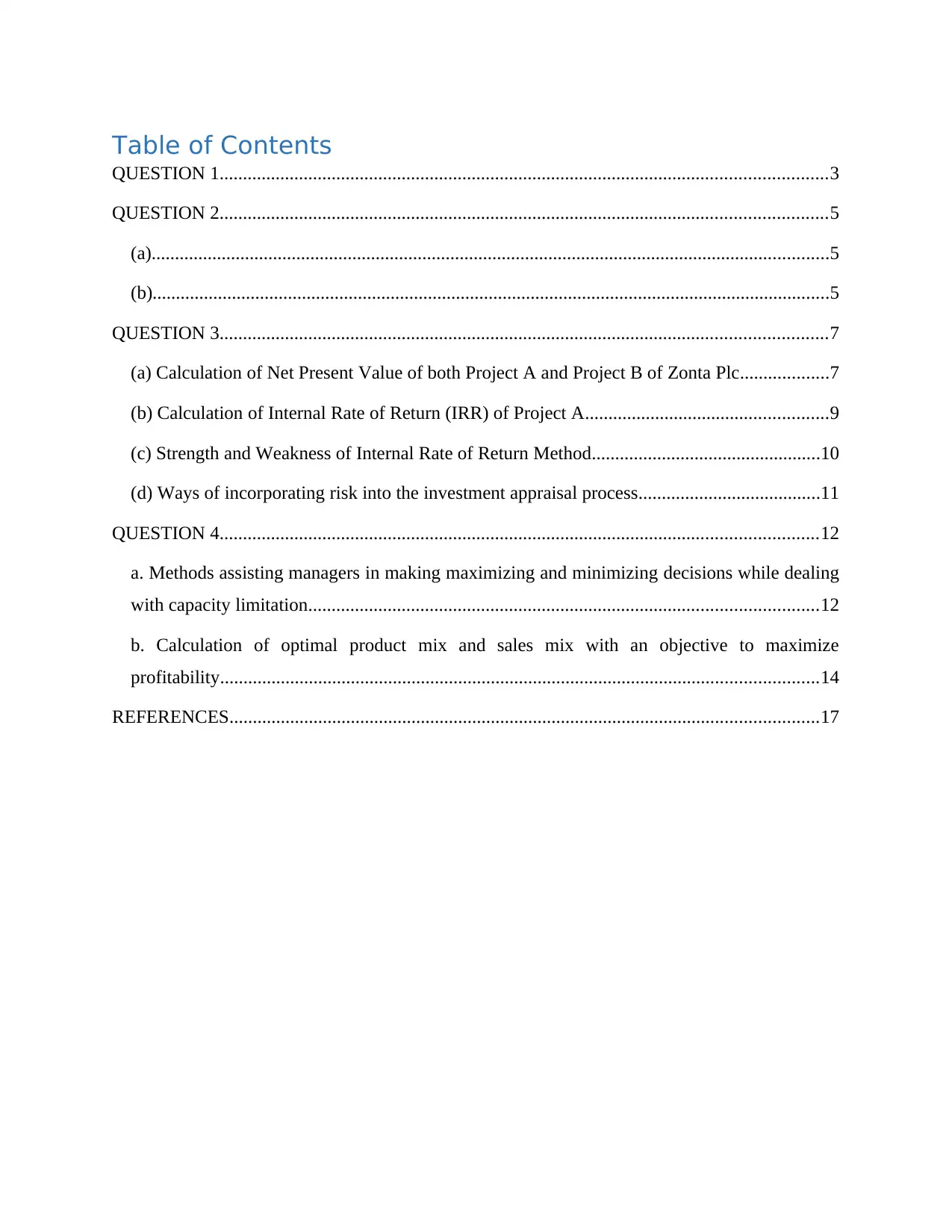
Table of Contents
QUESTION 1..................................................................................................................................3
QUESTION 2..................................................................................................................................5
(a).................................................................................................................................................5
(b).................................................................................................................................................5
QUESTION 3..................................................................................................................................7
(a) Calculation of Net Present Value of both Project A and Project B of Zonta Plc...................7
(b) Calculation of Internal Rate of Return (IRR) of Project A....................................................9
(c) Strength and Weakness of Internal Rate of Return Method.................................................10
(d) Ways of incorporating risk into the investment appraisal process.......................................11
QUESTION 4................................................................................................................................12
a. Methods assisting managers in making maximizing and minimizing decisions while dealing
with capacity limitation.............................................................................................................12
b. Calculation of optimal product mix and sales mix with an objective to maximize
profitability................................................................................................................................14
REFERENCES..............................................................................................................................17
QUESTION 1..................................................................................................................................3
QUESTION 2..................................................................................................................................5
(a).................................................................................................................................................5
(b).................................................................................................................................................5
QUESTION 3..................................................................................................................................7
(a) Calculation of Net Present Value of both Project A and Project B of Zonta Plc...................7
(b) Calculation of Internal Rate of Return (IRR) of Project A....................................................9
(c) Strength and Weakness of Internal Rate of Return Method.................................................10
(d) Ways of incorporating risk into the investment appraisal process.......................................11
QUESTION 4................................................................................................................................12
a. Methods assisting managers in making maximizing and minimizing decisions while dealing
with capacity limitation.............................................................................................................12
b. Calculation of optimal product mix and sales mix with an objective to maximize
profitability................................................................................................................................14
REFERENCES..............................................................................................................................17
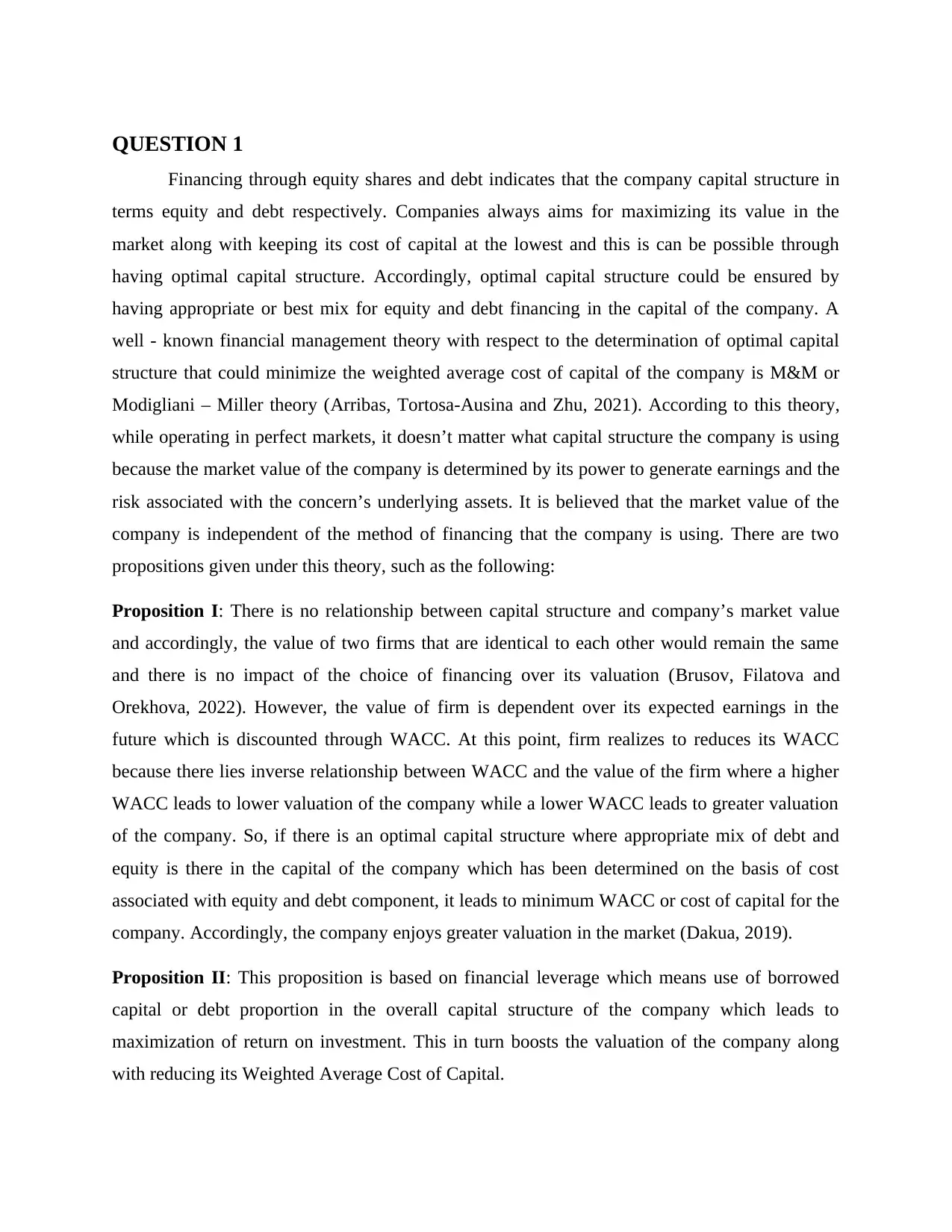
QUESTION 1
Financing through equity shares and debt indicates that the company capital structure in
terms equity and debt respectively. Companies always aims for maximizing its value in the
market along with keeping its cost of capital at the lowest and this is can be possible through
having optimal capital structure. Accordingly, optimal capital structure could be ensured by
having appropriate or best mix for equity and debt financing in the capital of the company. A
well - known financial management theory with respect to the determination of optimal capital
structure that could minimize the weighted average cost of capital of the company is M&M or
Modigliani – Miller theory (Arribas, Tortosa-Ausina and Zhu, 2021). According to this theory,
while operating in perfect markets, it doesn’t matter what capital structure the company is using
because the market value of the company is determined by its power to generate earnings and the
risk associated with the concern’s underlying assets. It is believed that the market value of the
company is independent of the method of financing that the company is using. There are two
propositions given under this theory, such as the following:
Proposition I: There is no relationship between capital structure and company’s market value
and accordingly, the value of two firms that are identical to each other would remain the same
and there is no impact of the choice of financing over its valuation (Brusov, Filatova and
Orekhova, 2022). However, the value of firm is dependent over its expected earnings in the
future which is discounted through WACC. At this point, firm realizes to reduces its WACC
because there lies inverse relationship between WACC and the value of the firm where a higher
WACC leads to lower valuation of the company while a lower WACC leads to greater valuation
of the company. So, if there is an optimal capital structure where appropriate mix of debt and
equity is there in the capital of the company which has been determined on the basis of cost
associated with equity and debt component, it leads to minimum WACC or cost of capital for the
company. Accordingly, the company enjoys greater valuation in the market (Dakua, 2019).
Proposition II: This proposition is based on financial leverage which means use of borrowed
capital or debt proportion in the overall capital structure of the company which leads to
maximization of return on investment. This in turn boosts the valuation of the company along
with reducing its Weighted Average Cost of Capital.
Financing through equity shares and debt indicates that the company capital structure in
terms equity and debt respectively. Companies always aims for maximizing its value in the
market along with keeping its cost of capital at the lowest and this is can be possible through
having optimal capital structure. Accordingly, optimal capital structure could be ensured by
having appropriate or best mix for equity and debt financing in the capital of the company. A
well - known financial management theory with respect to the determination of optimal capital
structure that could minimize the weighted average cost of capital of the company is M&M or
Modigliani – Miller theory (Arribas, Tortosa-Ausina and Zhu, 2021). According to this theory,
while operating in perfect markets, it doesn’t matter what capital structure the company is using
because the market value of the company is determined by its power to generate earnings and the
risk associated with the concern’s underlying assets. It is believed that the market value of the
company is independent of the method of financing that the company is using. There are two
propositions given under this theory, such as the following:
Proposition I: There is no relationship between capital structure and company’s market value
and accordingly, the value of two firms that are identical to each other would remain the same
and there is no impact of the choice of financing over its valuation (Brusov, Filatova and
Orekhova, 2022). However, the value of firm is dependent over its expected earnings in the
future which is discounted through WACC. At this point, firm realizes to reduces its WACC
because there lies inverse relationship between WACC and the value of the firm where a higher
WACC leads to lower valuation of the company while a lower WACC leads to greater valuation
of the company. So, if there is an optimal capital structure where appropriate mix of debt and
equity is there in the capital of the company which has been determined on the basis of cost
associated with equity and debt component, it leads to minimum WACC or cost of capital for the
company. Accordingly, the company enjoys greater valuation in the market (Dakua, 2019).
Proposition II: This proposition is based on financial leverage which means use of borrowed
capital or debt proportion in the overall capital structure of the company which leads to
maximization of return on investment. This in turn boosts the valuation of the company along
with reducing its Weighted Average Cost of Capital.
⊘ This is a preview!⊘
Do you want full access?
Subscribe today to unlock all pages.

Trusted by 1+ million students worldwide

Also, as per the theory based on Net Income Approach, it is believed that company’s
value can be increased with the reduction in the overall cost of capital or WACC. It is possible
for the firm to reduce its WACC by including greater proportion of debt rather equity in the
overall capital structure of the company as the former is considered to be cheaper than the
former. Debt reduces the WACC as Weighted Average Cost of Capital is determined through
multiplying cost of debt and cost of equity with the weights of equity and debt components
respectively in the overall capital structure of the company. Therefore, as per the net income
approach, it has been stated that a change in company’s financial leverage leads to a change in
the weighted average cost of capital which in turn changes the valuation of the company
(Rahman, Sarker and Uddin, 2019).
value can be increased with the reduction in the overall cost of capital or WACC. It is possible
for the firm to reduce its WACC by including greater proportion of debt rather equity in the
overall capital structure of the company as the former is considered to be cheaper than the
former. Debt reduces the WACC as Weighted Average Cost of Capital is determined through
multiplying cost of debt and cost of equity with the weights of equity and debt components
respectively in the overall capital structure of the company. Therefore, as per the net income
approach, it has been stated that a change in company’s financial leverage leads to a change in
the weighted average cost of capital which in turn changes the valuation of the company
(Rahman, Sarker and Uddin, 2019).
Paraphrase This Document
Need a fresh take? Get an instant paraphrase of this document with our AI Paraphraser
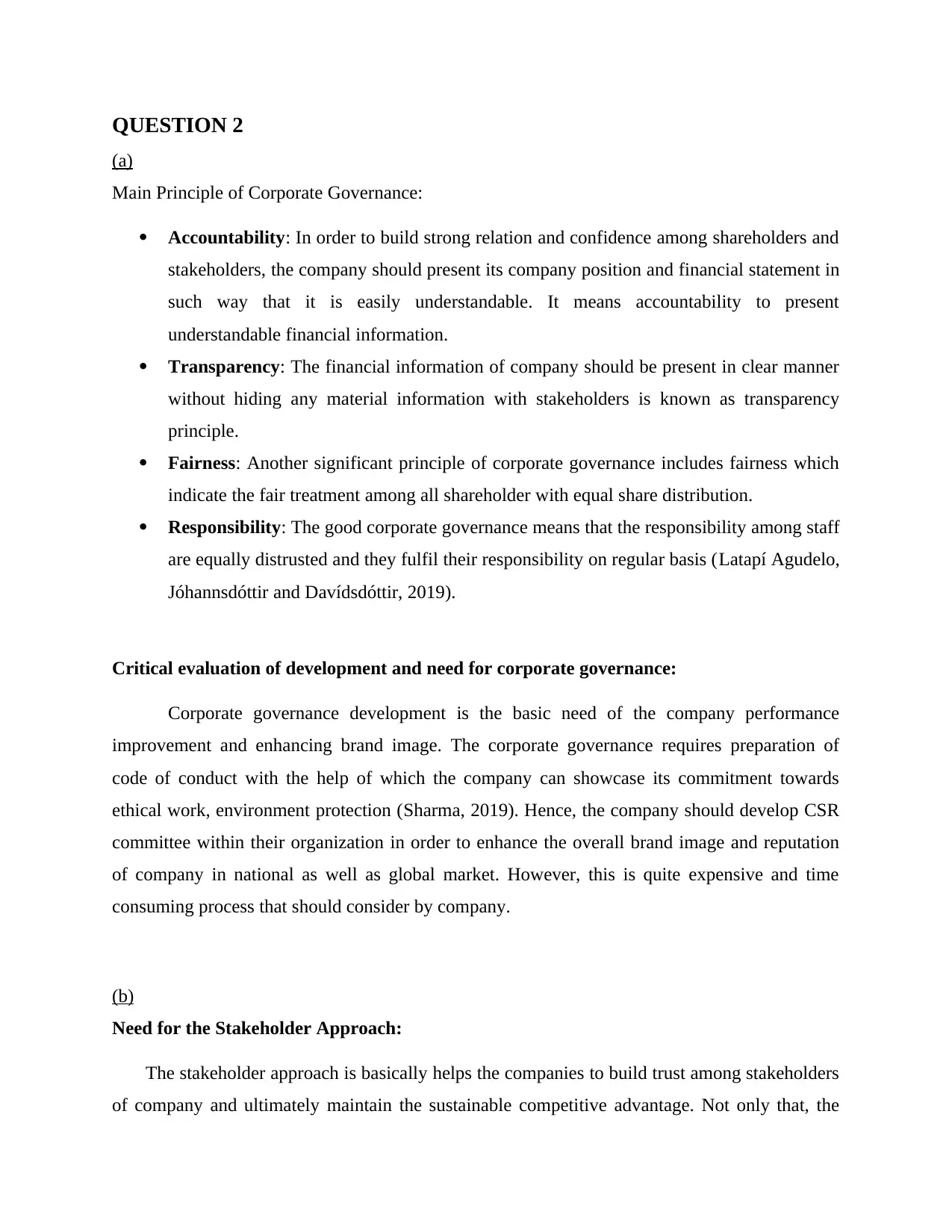
QUESTION 2
(a)
Main Principle of Corporate Governance:
Accountability: In order to build strong relation and confidence among shareholders and
stakeholders, the company should present its company position and financial statement in
such way that it is easily understandable. It means accountability to present
understandable financial information.
Transparency: The financial information of company should be present in clear manner
without hiding any material information with stakeholders is known as transparency
principle.
Fairness: Another significant principle of corporate governance includes fairness which
indicate the fair treatment among all shareholder with equal share distribution.
Responsibility: The good corporate governance means that the responsibility among staff
are equally distrusted and they fulfil their responsibility on regular basis (Latapí Agudelo,
Jóhannsdóttir and Davídsdóttir, 2019).
Critical evaluation of development and need for corporate governance:
Corporate governance development is the basic need of the company performance
improvement and enhancing brand image. The corporate governance requires preparation of
code of conduct with the help of which the company can showcase its commitment towards
ethical work, environment protection (Sharma, 2019). Hence, the company should develop CSR
committee within their organization in order to enhance the overall brand image and reputation
of company in national as well as global market. However, this is quite expensive and time
consuming process that should consider by company.
(b)
Need for the Stakeholder Approach:
The stakeholder approach is basically helps the companies to build trust among stakeholders
of company and ultimately maintain the sustainable competitive advantage. Not only that, the
(a)
Main Principle of Corporate Governance:
Accountability: In order to build strong relation and confidence among shareholders and
stakeholders, the company should present its company position and financial statement in
such way that it is easily understandable. It means accountability to present
understandable financial information.
Transparency: The financial information of company should be present in clear manner
without hiding any material information with stakeholders is known as transparency
principle.
Fairness: Another significant principle of corporate governance includes fairness which
indicate the fair treatment among all shareholder with equal share distribution.
Responsibility: The good corporate governance means that the responsibility among staff
are equally distrusted and they fulfil their responsibility on regular basis (Latapí Agudelo,
Jóhannsdóttir and Davídsdóttir, 2019).
Critical evaluation of development and need for corporate governance:
Corporate governance development is the basic need of the company performance
improvement and enhancing brand image. The corporate governance requires preparation of
code of conduct with the help of which the company can showcase its commitment towards
ethical work, environment protection (Sharma, 2019). Hence, the company should develop CSR
committee within their organization in order to enhance the overall brand image and reputation
of company in national as well as global market. However, this is quite expensive and time
consuming process that should consider by company.
(b)
Need for the Stakeholder Approach:
The stakeholder approach is basically helps the companies to build trust among stakeholders
of company and ultimately maintain the sustainable competitive advantage. Not only that, the
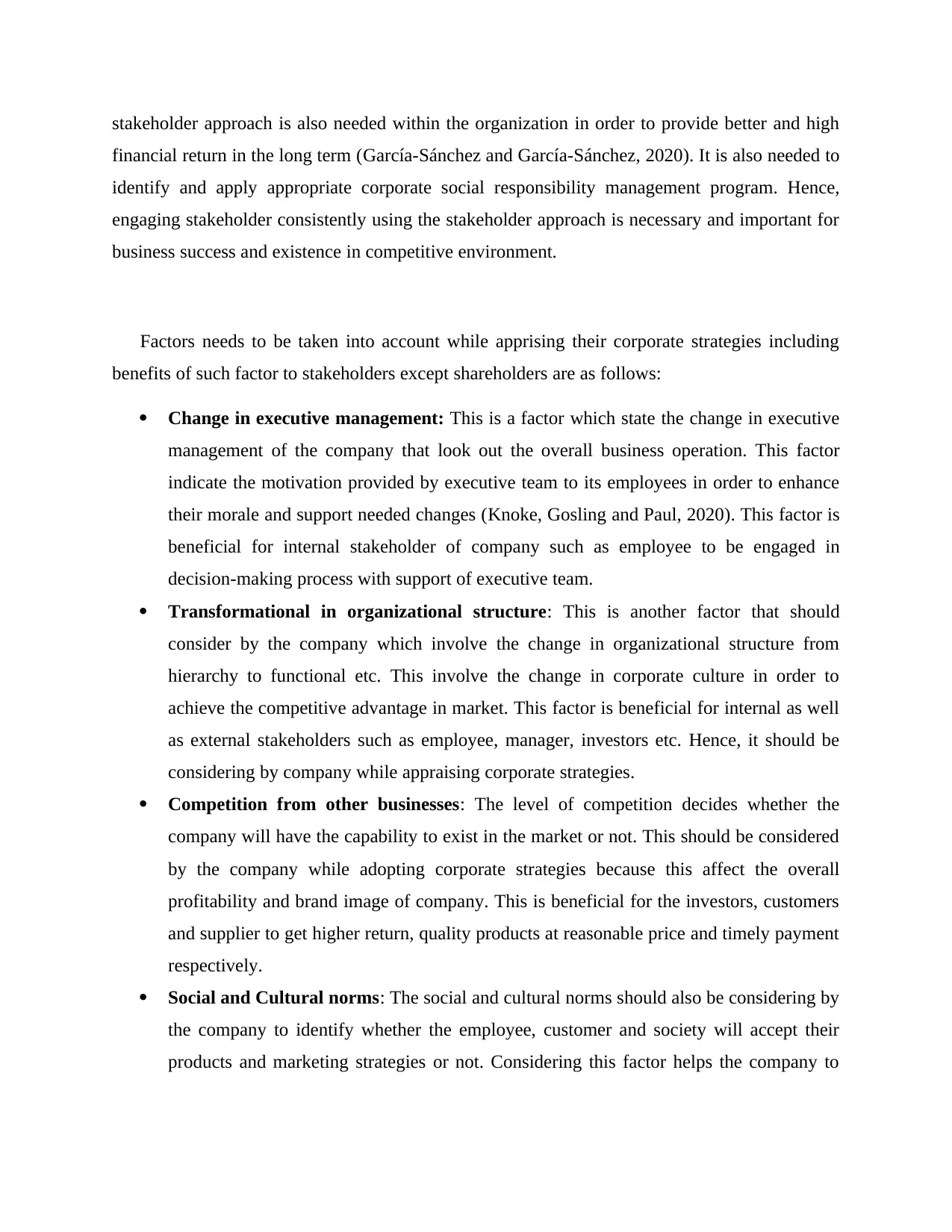
stakeholder approach is also needed within the organization in order to provide better and high
financial return in the long term (García-Sánchez and García-Sánchez, 2020). It is also needed to
identify and apply appropriate corporate social responsibility management program. Hence,
engaging stakeholder consistently using the stakeholder approach is necessary and important for
business success and existence in competitive environment.
Factors needs to be taken into account while apprising their corporate strategies including
benefits of such factor to stakeholders except shareholders are as follows:
Change in executive management: This is a factor which state the change in executive
management of the company that look out the overall business operation. This factor
indicate the motivation provided by executive team to its employees in order to enhance
their morale and support needed changes (Knoke, Gosling and Paul, 2020). This factor is
beneficial for internal stakeholder of company such as employee to be engaged in
decision-making process with support of executive team.
Transformational in organizational structure: This is another factor that should
consider by the company which involve the change in organizational structure from
hierarchy to functional etc. This involve the change in corporate culture in order to
achieve the competitive advantage in market. This factor is beneficial for internal as well
as external stakeholders such as employee, manager, investors etc. Hence, it should be
considering by company while appraising corporate strategies.
Competition from other businesses: The level of competition decides whether the
company will have the capability to exist in the market or not. This should be considered
by the company while adopting corporate strategies because this affect the overall
profitability and brand image of company. This is beneficial for the investors, customers
and supplier to get higher return, quality products at reasonable price and timely payment
respectively.
Social and Cultural norms: The social and cultural norms should also be considering by
the company to identify whether the employee, customer and society will accept their
products and marketing strategies or not. Considering this factor helps the company to
financial return in the long term (García-Sánchez and García-Sánchez, 2020). It is also needed to
identify and apply appropriate corporate social responsibility management program. Hence,
engaging stakeholder consistently using the stakeholder approach is necessary and important for
business success and existence in competitive environment.
Factors needs to be taken into account while apprising their corporate strategies including
benefits of such factor to stakeholders except shareholders are as follows:
Change in executive management: This is a factor which state the change in executive
management of the company that look out the overall business operation. This factor
indicate the motivation provided by executive team to its employees in order to enhance
their morale and support needed changes (Knoke, Gosling and Paul, 2020). This factor is
beneficial for internal stakeholder of company such as employee to be engaged in
decision-making process with support of executive team.
Transformational in organizational structure: This is another factor that should
consider by the company which involve the change in organizational structure from
hierarchy to functional etc. This involve the change in corporate culture in order to
achieve the competitive advantage in market. This factor is beneficial for internal as well
as external stakeholders such as employee, manager, investors etc. Hence, it should be
considering by company while appraising corporate strategies.
Competition from other businesses: The level of competition decides whether the
company will have the capability to exist in the market or not. This should be considered
by the company while adopting corporate strategies because this affect the overall
profitability and brand image of company. This is beneficial for the investors, customers
and supplier to get higher return, quality products at reasonable price and timely payment
respectively.
Social and Cultural norms: The social and cultural norms should also be considering by
the company to identify whether the employee, customer and society will accept their
products and marketing strategies or not. Considering this factor helps the company to
⊘ This is a preview!⊘
Do you want full access?
Subscribe today to unlock all pages.

Trusted by 1+ million students worldwide
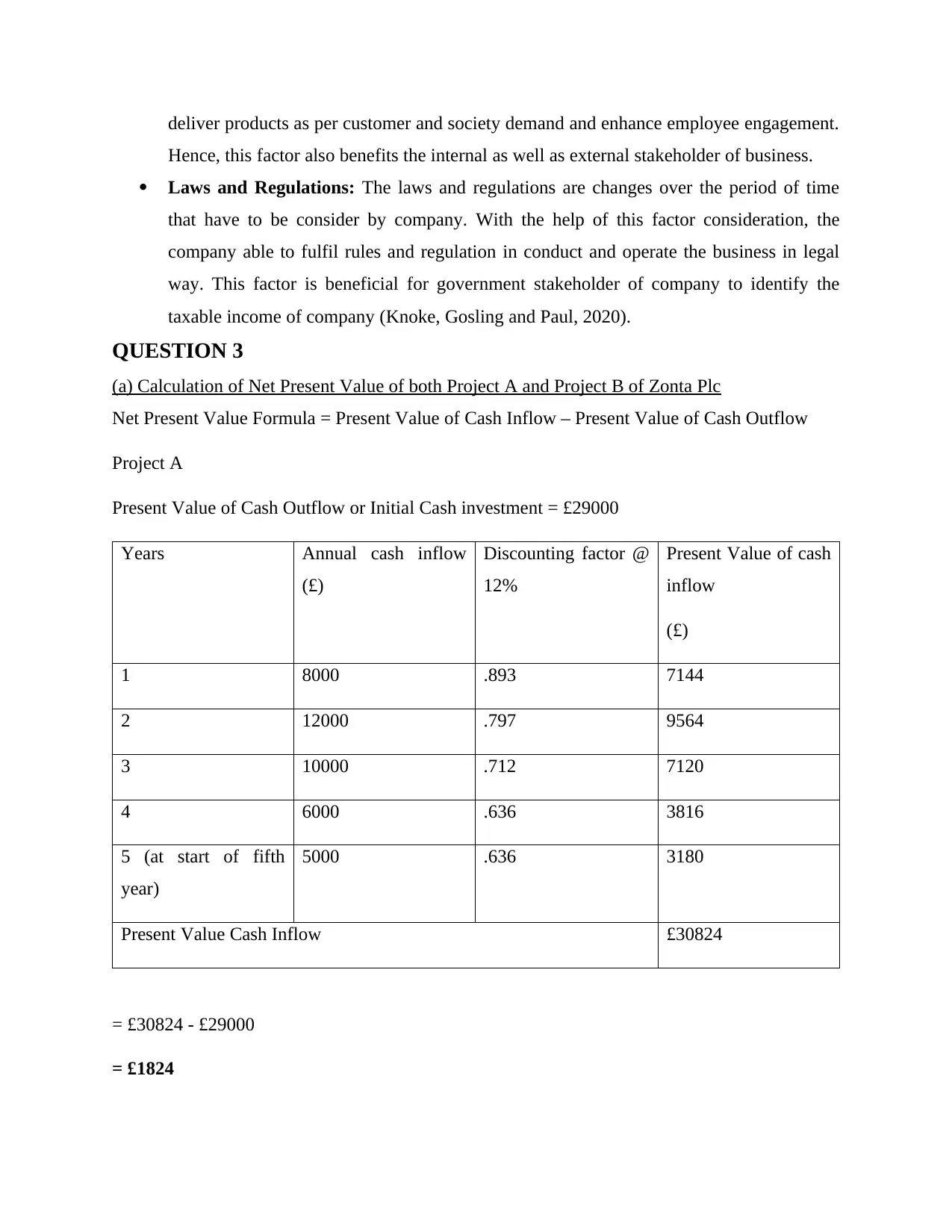
deliver products as per customer and society demand and enhance employee engagement.
Hence, this factor also benefits the internal as well as external stakeholder of business.
Laws and Regulations: The laws and regulations are changes over the period of time
that have to be consider by company. With the help of this factor consideration, the
company able to fulfil rules and regulation in conduct and operate the business in legal
way. This factor is beneficial for government stakeholder of company to identify the
taxable income of company (Knoke, Gosling and Paul, 2020).
QUESTION 3
(a) Calculation of Net Present Value of both Project A and Project B of Zonta Plc
Net Present Value Formula = Present Value of Cash Inflow – Present Value of Cash Outflow
Project A
Present Value of Cash Outflow or Initial Cash investment = £29000
Years Annual cash inflow
(£)
Discounting factor @
12%
Present Value of cash
inflow
(£)
1 8000 .893 7144
2 12000 .797 9564
3 10000 .712 7120
4 6000 .636 3816
5 (at start of fifth
year)
5000 .636 3180
Present Value Cash Inflow £30824
= £30824 - £29000
= £1824
Hence, this factor also benefits the internal as well as external stakeholder of business.
Laws and Regulations: The laws and regulations are changes over the period of time
that have to be consider by company. With the help of this factor consideration, the
company able to fulfil rules and regulation in conduct and operate the business in legal
way. This factor is beneficial for government stakeholder of company to identify the
taxable income of company (Knoke, Gosling and Paul, 2020).
QUESTION 3
(a) Calculation of Net Present Value of both Project A and Project B of Zonta Plc
Net Present Value Formula = Present Value of Cash Inflow – Present Value of Cash Outflow
Project A
Present Value of Cash Outflow or Initial Cash investment = £29000
Years Annual cash inflow
(£)
Discounting factor @
12%
Present Value of cash
inflow
(£)
1 8000 .893 7144
2 12000 .797 9564
3 10000 .712 7120
4 6000 .636 3816
5 (at start of fifth
year)
5000 .636 3180
Present Value Cash Inflow £30824
= £30824 - £29000
= £1824
Paraphrase This Document
Need a fresh take? Get an instant paraphrase of this document with our AI Paraphraser
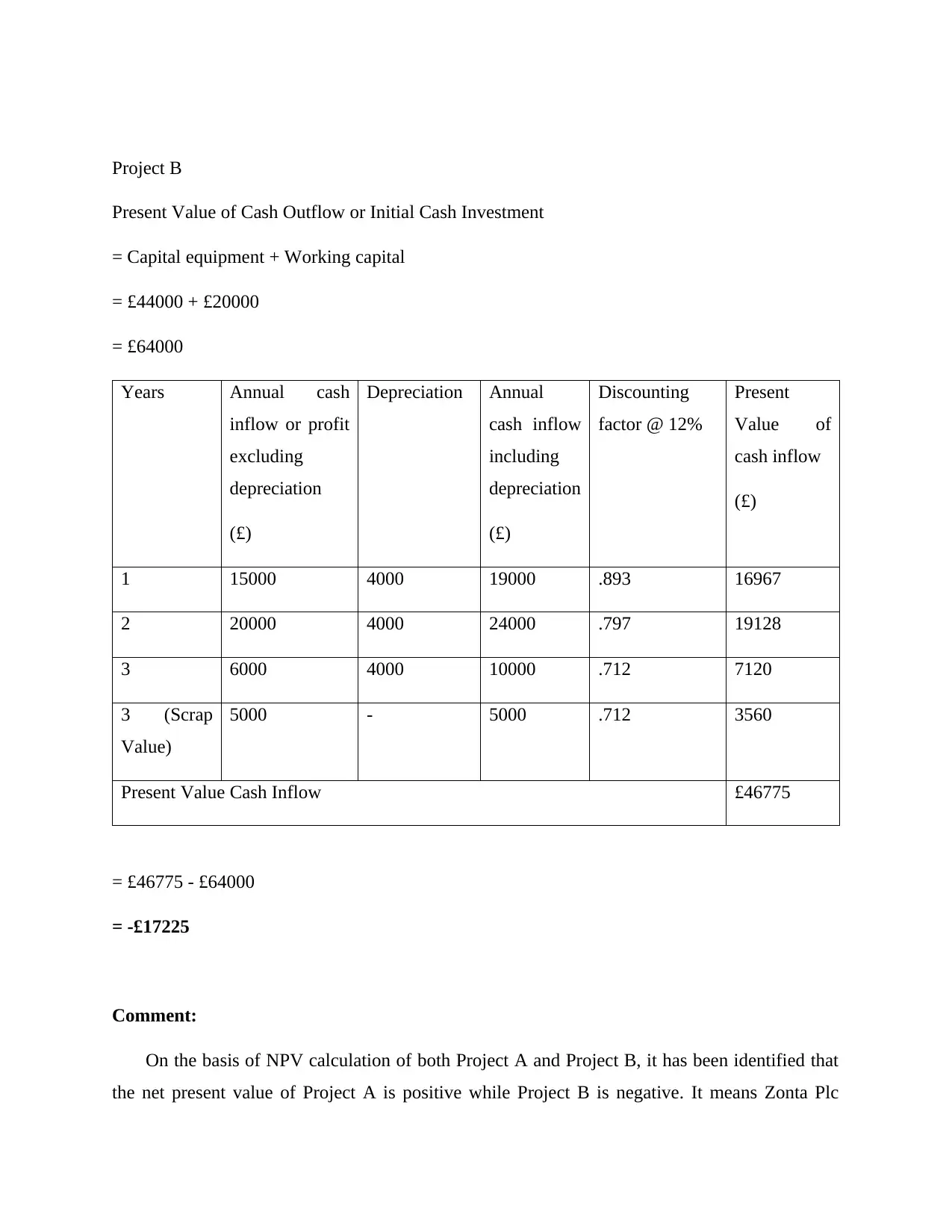
Project B
Present Value of Cash Outflow or Initial Cash Investment
= Capital equipment + Working capital
= £44000 + £20000
= £64000
Years Annual cash
inflow or profit
excluding
depreciation
(£)
Depreciation Annual
cash inflow
including
depreciation
(£)
Discounting
factor @ 12%
Present
Value of
cash inflow
(£)
1 15000 4000 19000 .893 16967
2 20000 4000 24000 .797 19128
3 6000 4000 10000 .712 7120
3 (Scrap
Value)
5000 - 5000 .712 3560
Present Value Cash Inflow £46775
= £46775 - £64000
= -£17225
Comment:
On the basis of NPV calculation of both Project A and Project B, it has been identified that
the net present value of Project A is positive while Project B is negative. It means Zonta Plc
Present Value of Cash Outflow or Initial Cash Investment
= Capital equipment + Working capital
= £44000 + £20000
= £64000
Years Annual cash
inflow or profit
excluding
depreciation
(£)
Depreciation Annual
cash inflow
including
depreciation
(£)
Discounting
factor @ 12%
Present
Value of
cash inflow
(£)
1 15000 4000 19000 .893 16967
2 20000 4000 24000 .797 19128
3 6000 4000 10000 .712 7120
3 (Scrap
Value)
5000 - 5000 .712 3560
Present Value Cash Inflow £46775
= £46775 - £64000
= -£17225
Comment:
On the basis of NPV calculation of both Project A and Project B, it has been identified that
the net present value of Project A is positive while Project B is negative. It means Zonta Plc
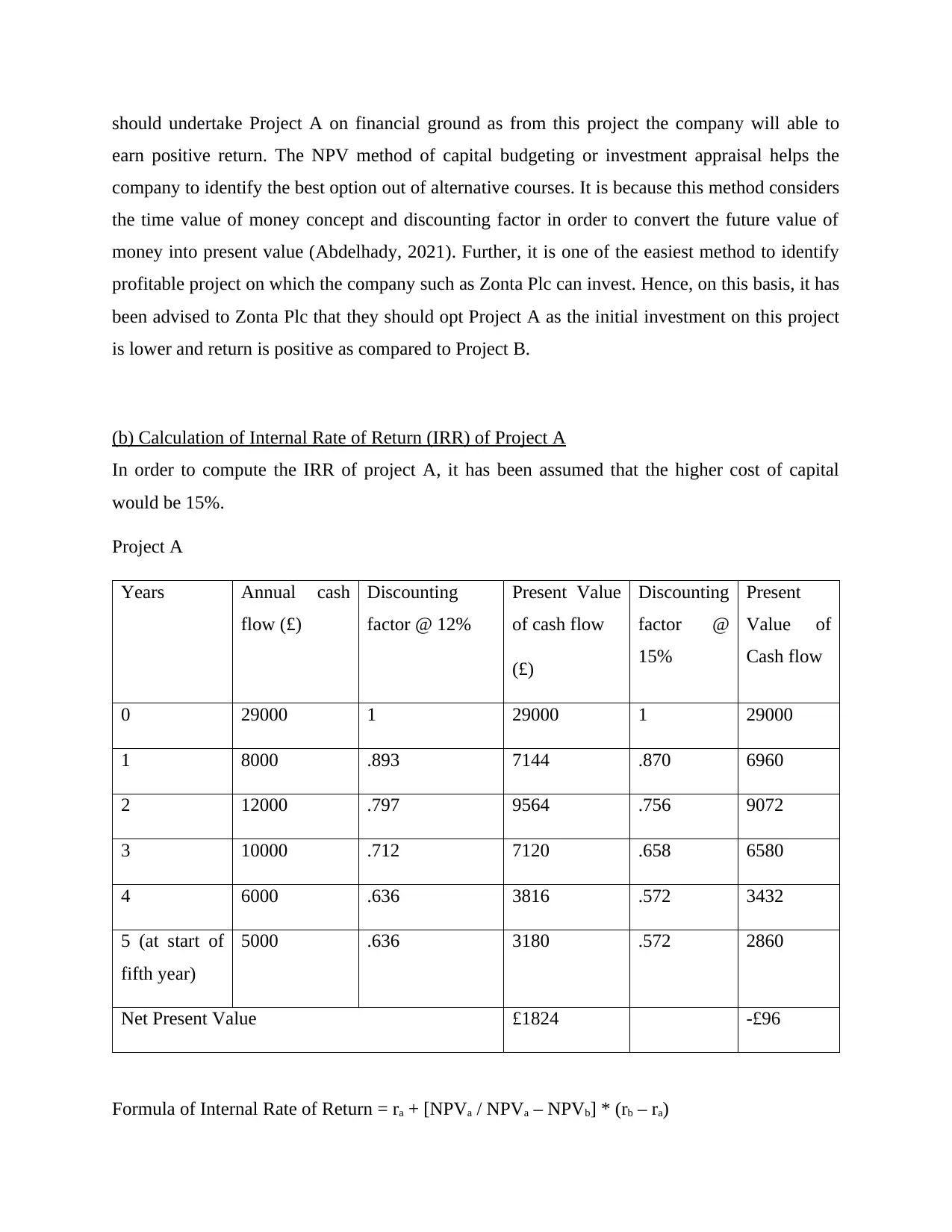
should undertake Project A on financial ground as from this project the company will able to
earn positive return. The NPV method of capital budgeting or investment appraisal helps the
company to identify the best option out of alternative courses. It is because this method considers
the time value of money concept and discounting factor in order to convert the future value of
money into present value (Abdelhady, 2021). Further, it is one of the easiest method to identify
profitable project on which the company such as Zonta Plc can invest. Hence, on this basis, it has
been advised to Zonta Plc that they should opt Project A as the initial investment on this project
is lower and return is positive as compared to Project B.
(b) Calculation of Internal Rate of Return (IRR) of Project A
In order to compute the IRR of project A, it has been assumed that the higher cost of capital
would be 15%.
Project A
Years Annual cash
flow (£)
Discounting
factor @ 12%
Present Value
of cash flow
(£)
Discounting
factor @
15%
Present
Value of
Cash flow
0 29000 1 29000 1 29000
1 8000 .893 7144 .870 6960
2 12000 .797 9564 .756 9072
3 10000 .712 7120 .658 6580
4 6000 .636 3816 .572 3432
5 (at start of
fifth year)
5000 .636 3180 .572 2860
Net Present Value £1824 -£96
Formula of Internal Rate of Return = ra + [NPVa / NPVa – NPVb] * (rb – ra)
earn positive return. The NPV method of capital budgeting or investment appraisal helps the
company to identify the best option out of alternative courses. It is because this method considers
the time value of money concept and discounting factor in order to convert the future value of
money into present value (Abdelhady, 2021). Further, it is one of the easiest method to identify
profitable project on which the company such as Zonta Plc can invest. Hence, on this basis, it has
been advised to Zonta Plc that they should opt Project A as the initial investment on this project
is lower and return is positive as compared to Project B.
(b) Calculation of Internal Rate of Return (IRR) of Project A
In order to compute the IRR of project A, it has been assumed that the higher cost of capital
would be 15%.
Project A
Years Annual cash
flow (£)
Discounting
factor @ 12%
Present Value
of cash flow
(£)
Discounting
factor @
15%
Present
Value of
Cash flow
0 29000 1 29000 1 29000
1 8000 .893 7144 .870 6960
2 12000 .797 9564 .756 9072
3 10000 .712 7120 .658 6580
4 6000 .636 3816 .572 3432
5 (at start of
fifth year)
5000 .636 3180 .572 2860
Net Present Value £1824 -£96
Formula of Internal Rate of Return = ra + [NPVa / NPVa – NPVb] * (rb – ra)
⊘ This is a preview!⊘
Do you want full access?
Subscribe today to unlock all pages.

Trusted by 1+ million students worldwide
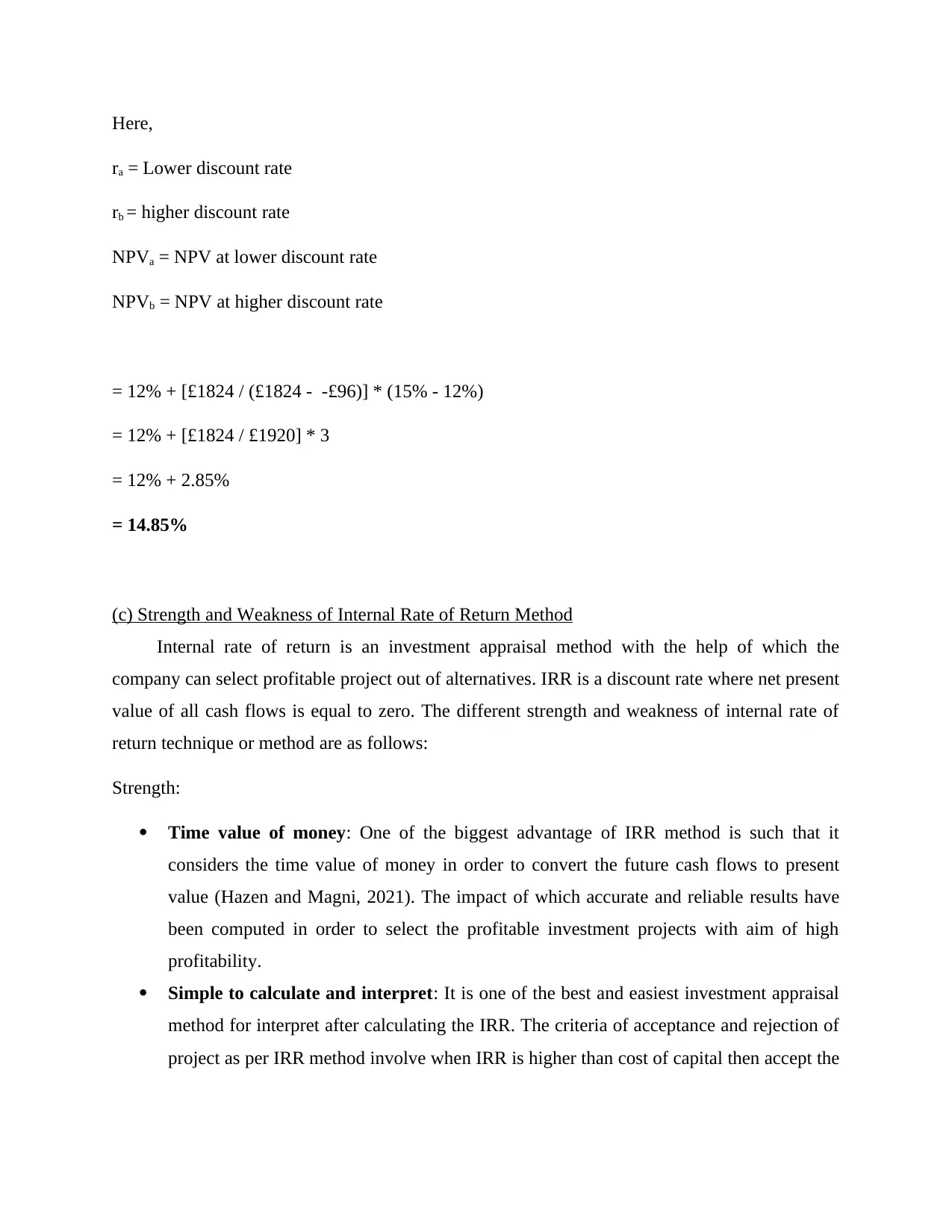
Here,
ra = Lower discount rate
rb = higher discount rate
NPVa = NPV at lower discount rate
NPVb = NPV at higher discount rate
= 12% + [£1824 / (£1824 - -£96)] * (15% - 12%)
= 12% + [£1824 / £1920] * 3
= 12% + 2.85%
= 14.85%
(c) Strength and Weakness of Internal Rate of Return Method
Internal rate of return is an investment appraisal method with the help of which the
company can select profitable project out of alternatives. IRR is a discount rate where net present
value of all cash flows is equal to zero. The different strength and weakness of internal rate of
return technique or method are as follows:
Strength:
Time value of money: One of the biggest advantage of IRR method is such that it
considers the time value of money in order to convert the future cash flows to present
value (Hazen and Magni, 2021). The impact of which accurate and reliable results have
been computed in order to select the profitable investment projects with aim of high
profitability.
Simple to calculate and interpret: It is one of the best and easiest investment appraisal
method for interpret after calculating the IRR. The criteria of acceptance and rejection of
project as per IRR method involve when IRR is higher than cost of capital then accept the
ra = Lower discount rate
rb = higher discount rate
NPVa = NPV at lower discount rate
NPVb = NPV at higher discount rate
= 12% + [£1824 / (£1824 - -£96)] * (15% - 12%)
= 12% + [£1824 / £1920] * 3
= 12% + 2.85%
= 14.85%
(c) Strength and Weakness of Internal Rate of Return Method
Internal rate of return is an investment appraisal method with the help of which the
company can select profitable project out of alternatives. IRR is a discount rate where net present
value of all cash flows is equal to zero. The different strength and weakness of internal rate of
return technique or method are as follows:
Strength:
Time value of money: One of the biggest advantage of IRR method is such that it
considers the time value of money in order to convert the future cash flows to present
value (Hazen and Magni, 2021). The impact of which accurate and reliable results have
been computed in order to select the profitable investment projects with aim of high
profitability.
Simple to calculate and interpret: It is one of the best and easiest investment appraisal
method for interpret after calculating the IRR. The criteria of acceptance and rejection of
project as per IRR method involve when IRR is higher than cost of capital then accept the
Paraphrase This Document
Need a fresh take? Get an instant paraphrase of this document with our AI Paraphraser
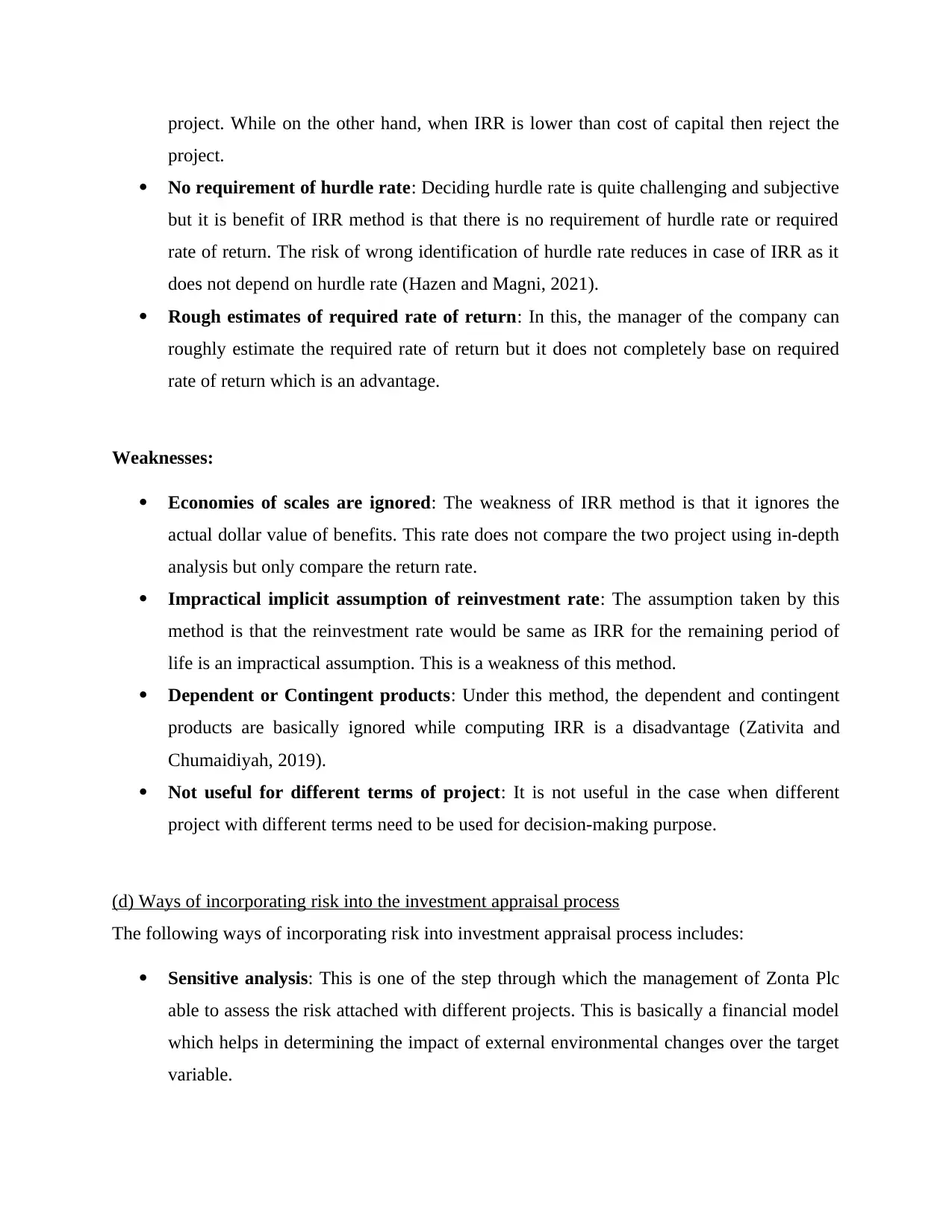
project. While on the other hand, when IRR is lower than cost of capital then reject the
project.
No requirement of hurdle rate: Deciding hurdle rate is quite challenging and subjective
but it is benefit of IRR method is that there is no requirement of hurdle rate or required
rate of return. The risk of wrong identification of hurdle rate reduces in case of IRR as it
does not depend on hurdle rate (Hazen and Magni, 2021).
Rough estimates of required rate of return: In this, the manager of the company can
roughly estimate the required rate of return but it does not completely base on required
rate of return which is an advantage.
Weaknesses:
Economies of scales are ignored: The weakness of IRR method is that it ignores the
actual dollar value of benefits. This rate does not compare the two project using in-depth
analysis but only compare the return rate.
Impractical implicit assumption of reinvestment rate: The assumption taken by this
method is that the reinvestment rate would be same as IRR for the remaining period of
life is an impractical assumption. This is a weakness of this method.
Dependent or Contingent products: Under this method, the dependent and contingent
products are basically ignored while computing IRR is a disadvantage (Zativita and
Chumaidiyah, 2019).
Not useful for different terms of project: It is not useful in the case when different
project with different terms need to be used for decision-making purpose.
(d) Ways of incorporating risk into the investment appraisal process
The following ways of incorporating risk into investment appraisal process includes:
Sensitive analysis: This is one of the step through which the management of Zonta Plc
able to assess the risk attached with different projects. This is basically a financial model
which helps in determining the impact of external environmental changes over the target
variable.
project.
No requirement of hurdle rate: Deciding hurdle rate is quite challenging and subjective
but it is benefit of IRR method is that there is no requirement of hurdle rate or required
rate of return. The risk of wrong identification of hurdle rate reduces in case of IRR as it
does not depend on hurdle rate (Hazen and Magni, 2021).
Rough estimates of required rate of return: In this, the manager of the company can
roughly estimate the required rate of return but it does not completely base on required
rate of return which is an advantage.
Weaknesses:
Economies of scales are ignored: The weakness of IRR method is that it ignores the
actual dollar value of benefits. This rate does not compare the two project using in-depth
analysis but only compare the return rate.
Impractical implicit assumption of reinvestment rate: The assumption taken by this
method is that the reinvestment rate would be same as IRR for the remaining period of
life is an impractical assumption. This is a weakness of this method.
Dependent or Contingent products: Under this method, the dependent and contingent
products are basically ignored while computing IRR is a disadvantage (Zativita and
Chumaidiyah, 2019).
Not useful for different terms of project: It is not useful in the case when different
project with different terms need to be used for decision-making purpose.
(d) Ways of incorporating risk into the investment appraisal process
The following ways of incorporating risk into investment appraisal process includes:
Sensitive analysis: This is one of the step through which the management of Zonta Plc
able to assess the risk attached with different projects. This is basically a financial model
which helps in determining the impact of external environmental changes over the target
variable.
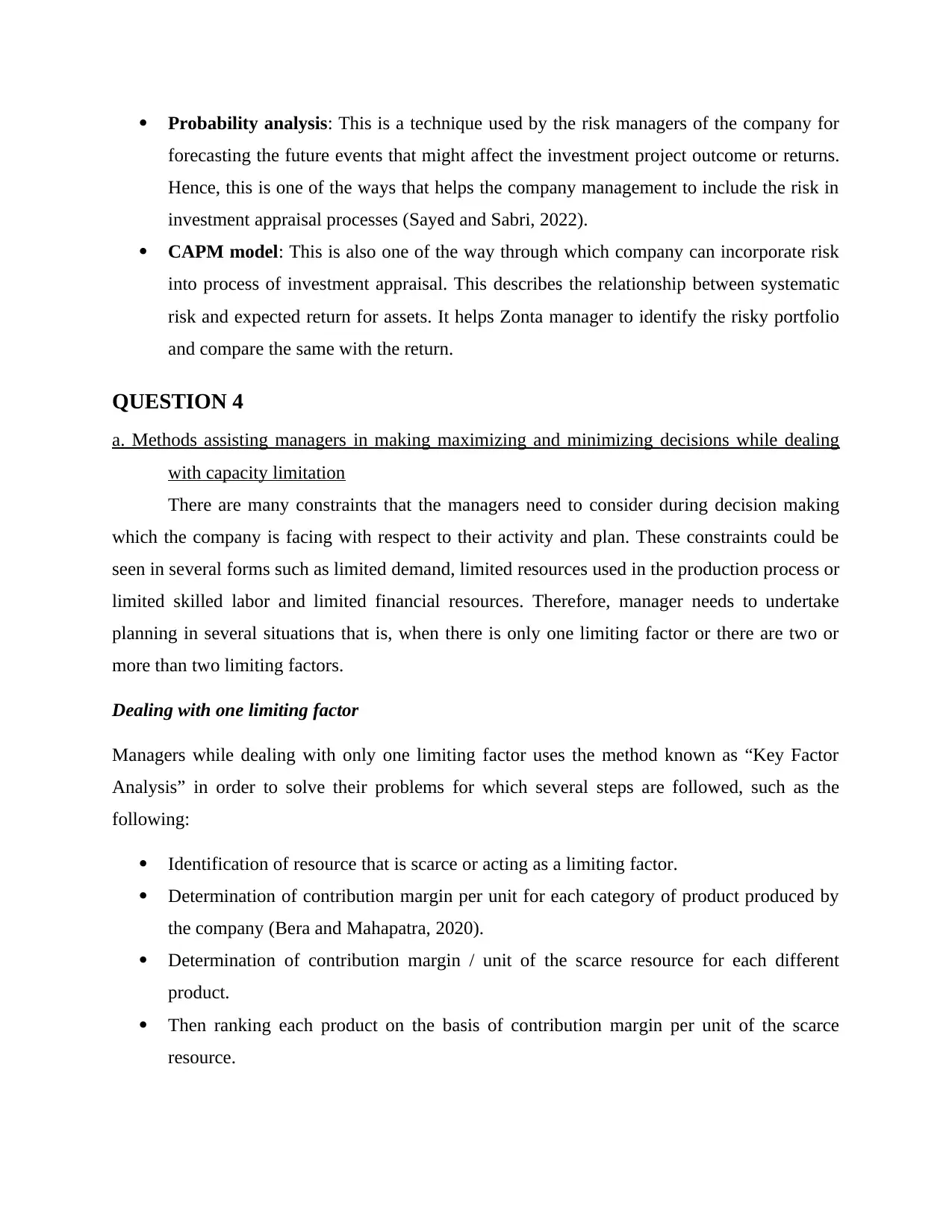
Probability analysis: This is a technique used by the risk managers of the company for
forecasting the future events that might affect the investment project outcome or returns.
Hence, this is one of the ways that helps the company management to include the risk in
investment appraisal processes (Sayed and Sabri, 2022).
CAPM model: This is also one of the way through which company can incorporate risk
into process of investment appraisal. This describes the relationship between systematic
risk and expected return for assets. It helps Zonta manager to identify the risky portfolio
and compare the same with the return.
QUESTION 4
a. Methods assisting managers in making maximizing and minimizing decisions while dealing
with capacity limitation
There are many constraints that the managers need to consider during decision making
which the company is facing with respect to their activity and plan. These constraints could be
seen in several forms such as limited demand, limited resources used in the production process or
limited skilled labor and limited financial resources. Therefore, manager needs to undertake
planning in several situations that is, when there is only one limiting factor or there are two or
more than two limiting factors.
Dealing with one limiting factor
Managers while dealing with only one limiting factor uses the method known as “Key Factor
Analysis” in order to solve their problems for which several steps are followed, such as the
following:
Identification of resource that is scarce or acting as a limiting factor.
Determination of contribution margin per unit for each category of product produced by
the company (Bera and Mahapatra, 2020).
Determination of contribution margin / unit of the scarce resource for each different
product.
Then ranking each product on the basis of contribution margin per unit of the scarce
resource.
forecasting the future events that might affect the investment project outcome or returns.
Hence, this is one of the ways that helps the company management to include the risk in
investment appraisal processes (Sayed and Sabri, 2022).
CAPM model: This is also one of the way through which company can incorporate risk
into process of investment appraisal. This describes the relationship between systematic
risk and expected return for assets. It helps Zonta manager to identify the risky portfolio
and compare the same with the return.
QUESTION 4
a. Methods assisting managers in making maximizing and minimizing decisions while dealing
with capacity limitation
There are many constraints that the managers need to consider during decision making
which the company is facing with respect to their activity and plan. These constraints could be
seen in several forms such as limited demand, limited resources used in the production process or
limited skilled labor and limited financial resources. Therefore, manager needs to undertake
planning in several situations that is, when there is only one limiting factor or there are two or
more than two limiting factors.
Dealing with one limiting factor
Managers while dealing with only one limiting factor uses the method known as “Key Factor
Analysis” in order to solve their problems for which several steps are followed, such as the
following:
Identification of resource that is scarce or acting as a limiting factor.
Determination of contribution margin per unit for each category of product produced by
the company (Bera and Mahapatra, 2020).
Determination of contribution margin / unit of the scarce resource for each different
product.
Then ranking each product on the basis of contribution margin per unit of the scarce
resource.
⊘ This is a preview!⊘
Do you want full access?
Subscribe today to unlock all pages.

Trusted by 1+ million students worldwide
1 out of 18
Related Documents
Your All-in-One AI-Powered Toolkit for Academic Success.
+13062052269
info@desklib.com
Available 24*7 on WhatsApp / Email
![[object Object]](/_next/static/media/star-bottom.7253800d.svg)
Unlock your academic potential
Copyright © 2020–2025 A2Z Services. All Rights Reserved. Developed and managed by ZUCOL.




